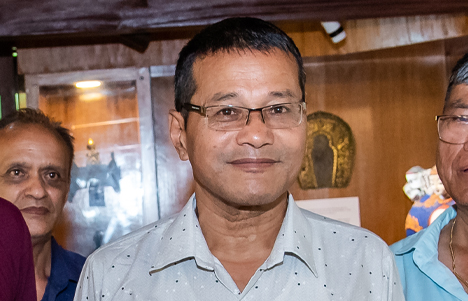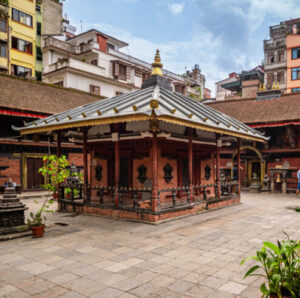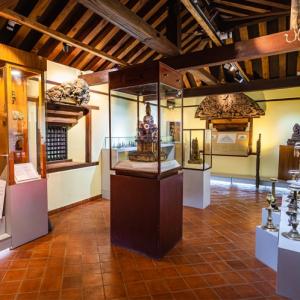
An Interview with Pragya Ratna Shakya, President of the Keshchandra Mahavihar Conservation Society
with Rubin Museum Executive Director Jorrit Britschgi
Rubin Museum Executive Director Jorrit Britschgi interviews Pragya Ratna Shakya, president of the Keshchandra Mahavihar Conservation Society, about the first year of the Itumbaha Museum.
This interview was conducted in early July, 2024. The answers have been translated from Newari.
Jorrit Britschgi: It has been almost a year since the inauguration of the museum galleries in the Itumbaha. What have you experienced during the first year?
Pragya Ratna Shakya: The first year has been quite satisfactory, we saw nearly 3,500 visitors, which includes 25% foreign nationals and 75% local visitors. As word spreads, we expect more visitors in the coming years. The visitors are happy with the display of artifacts at the museum, and the community has plans to slightly expand the gallery spaces and number of artifacts on display. We are proud to have welcomed many students, scholars, intellectuals, and research fellows, as well as notable religious and political leaders in the first year of operating the museum.
There are many similar religious sites in the Kathmandu Valley. How did your colleagues from other Newar Buddhist monasteries respond to the museum project?
We’ve had quite a number of inquiries from representatives of other monasteries in the Kathmandu Valley who visited the Itumbaha museum and expressed interest in opening small museums on their own premises. They often inquired about the fundraising, management, and security necessary for opening and operating a museum. The success of Itumbaha museum will be an encouraging model for other Newar Buddhist monasteries in the Kathmandu Valley.
Traditionally, once a year during the Gunla festival, the Itumbaha community presents objects from the monastery in its courtyard. Have you continued this tradition now that you have a museum?
The month-long Gunla festival is soon happening and will be celebrated with the usual deep cultural and religious devotion. It includes rituals like a daily hike to Swayambhu, the chanting of hymns and prayers, taking vows, and visits to different monasteries with traditional music. The Itumbaha community will actively participate in all the cultural and religious events.
As part of the festival, religious objects such as stupas, statues, sacred texts, and scroll paintings, as well as nonreligious artifacts that have been gifted to the monastery over the course of time, are presented in the courtyard for a duration of 15 days, from the seventh to the twenty-first day of the festival. This tradition will continue as it has for many generations, and it is practiced in other Buddhist monasteries as well.
The display of objects in the courtyard has two specific purposes: to affirm trust in the preservation committee for keeping objects safe, and to encourage further donations to the monastery. The display itself is an ancient version of a “museum” in a traditional way. We expect many visitors during this time of year to witness old religious artifacts and sacred images.
A year ago, when the museum opened, there was some opposition to the project, including criticism of the Western influence and “museumification” of an active sacred space. A year later are you still receiving this feedback, and what is your response to it?
Establishing a museum has been a dream project for the Itumbaha community for a long time. But there are still some people outside our community who are quite unhappy with the museum having opened. I’d like to point out that none of the objects on display are used in daily rituals or are still being venerated. They all came from various storages, and making them part of the display allows people to see them and makes them accessible for research.
The dissatisfaction that was initially expressed has now subsided. Some of the initial critics and protesters have paid a visit to the museum and have realized that they have been misguided and misinformed. Others still oppose the museum but have unfortunately not been in touch with our community.
In terms of sacred images presented in a museum context, some talk about a fear of the object losing its religious function. What is little discussed is that some objects may actually have been ritually decommissioned and replaced, and looking at an artifact as only a religious icon strips them of important other meanings. How do you think about this topic?
In terms of consecrated objects, once they are damaged or broken, they lose their function as an object of veneration; damaged objects are no longer worshiped. Immediate replacement or repairing (jirnoddhara) is carried out to make it worthy for religious purposes. However, there are also non-consecrated artifacts or utensils that are used for religious rituals, and they therefore also hold religious meaning.
The museum project that the Itumbaha community envisioned many years ago has been realized, and it aims to address pressing issues of financial sustainability and engaging the community to keep sites protected and vibrant. What is the next step of the Itumbaha? What do you hope to accomplish in the next five years?
Operating a museum is the best option for the conservation of objects and preservation of our heritage. But there are some challenges with the financial sustainability of the museum. Sometimes we see five visitors a day, sometimes one hundred; it is very hard to predict and plan. We depend on ticket sales and hope more people will visit the museum in the future to generate income. What we do see is that some visitors support our work with donations on top of the admission fee, which is very helpful to also support the four staff who work in the museum. Additionally, the conservation society sets aside a percentage of its fund to support the museum. Another concern is security, and we have asked for a police post in Itumbaha to protect the site.
In the next five years, the Itumbaha community has plans to expand the galleries a bit and make the museum even more attractive for visitors. We hope the Itumbaha museum continues to welcome people to learn about our cultural and religious heritage, the value of the preserved objects, and preservation of the Itumbaha itself.

Pragya Ratna Shakya is the president of the Keshchandra Mahavihar Conservation Society, which manages the administrative, financial, and legal matters of the Itumbaha monastery, as well as the conservation and preservation of the monastery’s buildings and collection.



